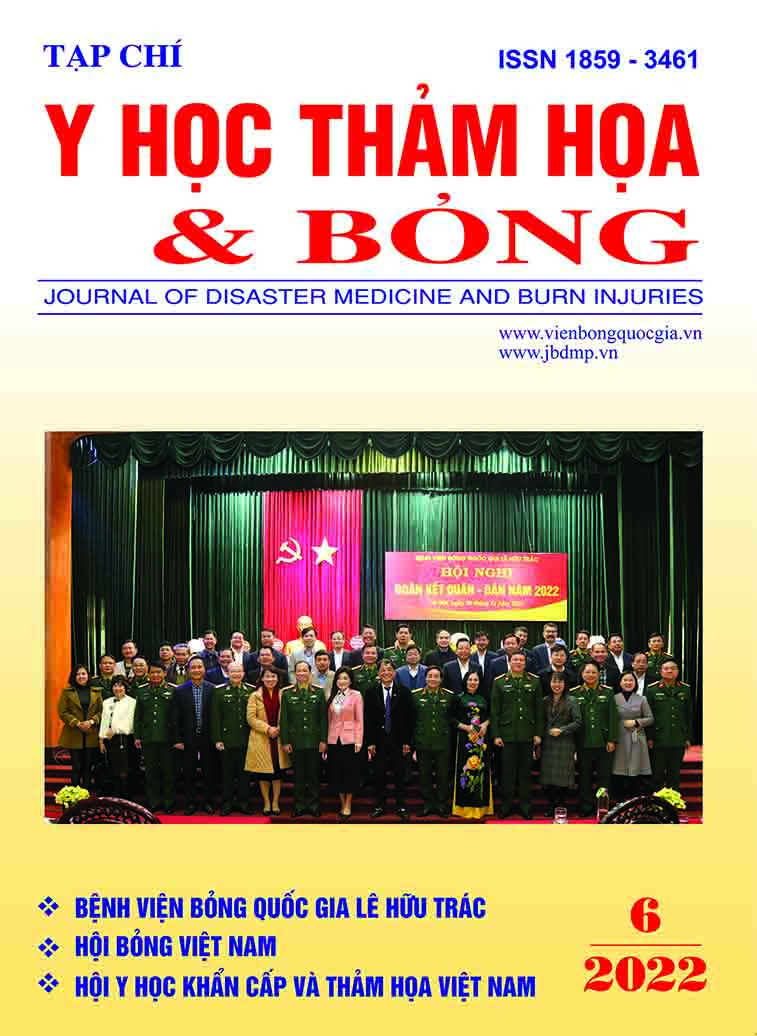The research on the treatment effects of nano Berberine gel on superficial burn thickness
Main Article Content
Abstract
Objectives: To evaluate the analgesic effect of nano Berberin gel in the treatment of superficial burns.
Subjective and Method: Study on 32 pediatric burn patients, treated at the Pediatric Burn Department in Le Huu Trac National Burn Hospital from 1 January 2022 to 30 April 2022. The method of study is a Prospective study, a randomized controlled trial. with comparison before-after. In the same patient, the burn was divided into 2 areas of equal area and depth. Study area: burns treated with a gel containing nano Berberine and comparison area: burns treated with 1% SSD cream.
Results: 1. Having an anti-inflammatory effect: Reduction of the degree and duration of inflammation and reduced significantly the exudation on the study burn wound compared to the control area.
2. Nano Berberin gel dries wet necrosis (obvious after 2 - 3 days of using the drug).
3. Gel has the effect of preventing infection. A significant reduction in the number of positive cultures and the number of bacteria after 1 - 2 weeks of treatment, (78.33 ± 46.69 vs 105.16 ± 91.28 p < 0.05). The number of infected wounds after 1 week also decreased significantly in the control area, (25% vs 61.5% in zone A; 33.3% vs 58.3% in zone B) p<0.05. 4. The time for 50% epithelialization, the treatment time in the study area is also shorter than in the control area, (6.9 ± 3.6 vs 8.1 ± 4.2; p < 0.05).
Conclusion: Initial remarkable recognition of the treatment effect of Nano Berberin Gel on the pediatric superficial burn.
Article Details
Keywords
Nano Berberine gel, superficial burn, pediatric
References
2. Branski LK, Al-Mousawi A, Rivero H, Jeschke MG, Sanford AP, Herndon DN. Emerging infections in burns. Surg Infect. 2009;10:38997
3. Lê Thế Trung (2003), “Bỏng- những kiến thức chuyên ngành”- NXB y học
4. Anna Och; Rafał Podgórski, R.N., Biological Activity of Berberine A Summary Update; 2020, 12(11), 713. Toxins, 2020. 12(11): p. 713
5. Wang Y., Z.J.A., Update on the Benefits and Mechanisms of Action of the Bioactive Vegetal Alkaloid Berberine on Lipid Metabolism and Homeostasis. Cholesterol., 2018. 2018: p. 717
6. E. Mirhadi, M. Rezaee, and B. Malaekeh-Nikouei (2018), Nano strategies for berberine delivery, a natural alkaloid of Berberis, Biomed. Pharmacother., 104, pp.465-473
7. Nguyễn Ngọc Tuấn, Đại cương bỏng, Giáo trình bỏng (dùng cho đào tạo trình độ sau đại học), Nhà xuất bản Quân đội Nhân dân, 2018, tr 13-33
8. Yu H.H., K.K.J., Cha J.D. et al., Antimicrobial Activity of Berberine Alone and in Combination with Ampicillin or Oxacillin Against Methicillin-Resistant S. aureus, Journal of Medicinal Food., 2005. 8(4): p. 454-461.
9. Košťálová; M.Č.D., Antimicrobial activity of berberine - a constituent of Mahonia aquifolium; Folia Microbiologica; 2002. 47(4): p. 375-378
10. Gilbs P.J., S.K.R., Berberine. Alternative Medicine Review, 2000. 5(2): p. 175.
11. Suliman Khan, Arif Hussain, Farnoosh Attar, Samir HajBloukh, ZehraEdis, MajidSharifi, review of the berberine natural polysaccharide nanostructures as potential anticancer and antibacterial agents; Biomedicine & Pharmacotherapy; Volume 146, February 2022, 112531
12. Ríos J.L., F.F., Schinella G.R., Natural Products for the Treatment of Type 2 Diabetes Mellitus; Planta Med.; 2015. 81(12-13): p. 975-94.
13. Nguyễn Tiến Dũng, Nguyễn Ngọc Tuấn, Nguyễn Thị Vân Anh (2014), Đánh giá tác dụng điều trị của kem Berberin 0,1% tại chỗ vết thương mạn tính, Tạp chí Y học thảm hoạ và Bỏng, số 5.


